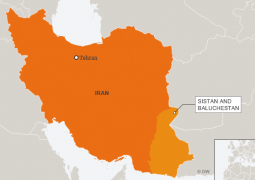Inside the Air Force’s dilapidated Reaper school
Inside the Air Force’s dilapidated Reaper school, which won’t be fixed anytime soon

Airmen with the 49th Aircraft Maintenance Squadron tow an MQ-9 Reaper remotely piloted aircraft from the flightline at Holloman Air Force Base, N.M., Dec. 16, 2016.
(Air Force photo / J.M. Eddins Jr.)
Deep in the desert of south-central New Mexico is a school unlike any other, where Air Force pilots learn to fly the MQ-9 Reaper. A multi-mission remotely-piloted aircraft (RPA), the Reaper has a range of duties, from scouting the battlefield to killing high-value targets like the late Iranian General Qasem Soleimani.
But as the school churns out hundreds of new MQ-9 pilots a year, the facility itself is falling apart. Airmen contend with a sinkhole under the building that threatens its stability, toilets and pipes that overflow and leak, and classrooms that do not have enough network ports or electrical outlets to support lessons on flying a 21st century aircraft.
The Air Force had $85 million lined up in the 2019 defense budget to fix the facility, but that money was diverted to help build a wall on the U.S. southern border with Mexico. The move angered New Mexico lawmakers and left RPA pilots at Holloman Air Force Base in the same ramshackle conditions.
Though the building is still safe for students, it costs four times as much money and man-hours to maintain than other facilities at Holloman, where the school is located, according to the base’s chief spokeswoman.
“Conditions are sufficient enough to conduct Formal Training Unit (FTU) operations that produce operationally ready MQ-9 aircrew; however, significant facility challenges remain,” Denise Ottaviano, Holloman’s chief of media relations, told Task & Purpose. “While the building is safe, it is not ideal, nor commensurate with other (even older) military training facilities.”
“Overall, it is not the world-class training facility we need for our next generation of aviators,” she added.
One Air Force officer with over 10 years of experience flying RPAs such as the Reaper put it more bluntly:
“When I hear crews talk about it, they’re like ‘oh my god, that place is a dumpster fire,'” he said.

Airmen inspect MQ-9 Reaper remotely piloted aircraft lined up in the 49th Aircraft Maintenance Squadron hangar at Holloman Air Force Base, N.M., Dec. 16, 2016.
(Air Force photo / J.M. Eddins Jr.)
‘There is a performance difference’
The officer, who spoke with Task & Purpose on condition of anonymity in order to provide a first-hand perspective of conditions at the base, said the decrepit facility has a direct effect on morale for the instructors there.
“There is a performance difference,” the officer said. “We try not to pick on anyone for it, but clearly it has an effect.”
The instructors at Holloman already have a heavy workload. In fiscal year 2019 alone, the base churned out 511 MQ-9 pilot and sensor operator graduates, Ottaviano said, with the program expected to train 310 MQ-9 pilots and 310 sensor operators during this fiscal year.
Under such a heavy workload, relatively small problems — such as not having enough network support for a classroom lecture — can start to add up.
“When the lesson calls for a computer program and there’s no working ethernet jack, you’re like ‘this lesson is going to go poorly,’” the officer said. “It’s like ‘I know I’m not supposed to be demoralized, but it’s 4 a.m. and I’m putting together another briefing and I’m exhausted’ … They have a massive workload in a condemned building and instruction quality suffers because they are exhausted.”
Building 302, as the facility is called, wasn’t originally designed as an RPA pilot training school. It first opened in 1942 as an aircraft general purpose shop, Ottaviano explained. Since then, it has served as an aircraft maintenance facility, weapons shop, civil engineer warehouse, academic facility, and housed an F-117 Stealth Fighter squadron before standing up MQ-1 and MQ-9 training operations in the mid-2000s.
2nd Lt. Timothy, remotely piloted aircraft student pilot, operates an MQ-9 flight simulator for training, Dec. 10, 2019, on Holloman Air Force Base. The 49th Wing is the largest formal training unit for MQ-9 RPA pilots and sensor operators.
Over the years, all the added mission requirements and insufficient upkeep funding has led to plumbing, electrical and HVAC problems, Ottaviano said, as well as issues with mold and bats in the ceiling.
“I do know they had to temporarily close one of the entrance doors a few years back,” the anonymous officer said. “Too much bat guano when the base civil engineers couldn’t find a way to permanently clear the infestation from the rafters.”
Now the building has an ultrasonic chirping emitter to drive the bats and birds away, the officer said, but other problems still linger. The sinkhole, for example, poses a threat to the building stability, Ottaviano said, the building doesn’t have the space to hold all squadron members for a mass briefing, and students often can’t plug in their computers all at once.
“A typical class of 20 students cannot all plug in their computers at the same time, due to a lack of network port and electrical outlet availability,” Ottaviano said, adding that technicians found there is no additional capacity for network connectivity within the building.
Not all Reaper instructors work in Building 302, the officer said: The 9th and 29th Attack Squadrons of the 49th Wing are housed in buildings that are in good condition. However, the 6th Attack Squadron is stuck with the one falling apart, the officer said.
While some instructors can rise above the infrastructural problems, it has a demoralizing effect on most, the officer explained.
“They get cues from the infrastructure,” he said. “They don’t take it as deadly seriously as they should be. They’re working very hard, it’s just you’re not getting the quality level you’d expect when learning the art of war.”

Senators Angus King and Martin Heinrich are seen at a Senate Armed Services Committee hearing on the nomination of the commander of U.S. Strategic Command, Air Force Gen. John E. Hyten, to be vice chairman of the Joint Chiefs of Staff, Washington, D.C., July 30, 2019.
(DoD photo / Lisa Ferdinando)
A fix that went south
To fix the myriad problems facing the facility, the Air Force dedicated $85 million in the fiscal year 2019 defense budget to building a brand new MQ-9 training center at Holloman. According to Ottaviano, it would have been quite snazzy, complete with MQ-9 simulators and ground control stations with secure brief/debrief capabilities and enhanced classrooms and training rooms that “could have enabled the MQ-9 FTU to produce higher quality MQ-9 aircrews,” she said.
“So if there’s essential agreement from the service chief, support from the legislature, and increasing demand for the Reaper in places where the operations have absolutely nothing to do with counterterrorism, why would an essential need continue to be ignored?” he asked.
Goldfein and other senior Air Force leaders “would like to fund this facility, but in a large bureaucracy there are many needs in many places, and the staff at a headquarters has surprising power to sneak some needs up the priority list and bury others,” the officer said.
Some within the Air Force have either misunderstood the MQ-9 or disagreed with RPAs being an integral part of both conventional and special operations for the long haul, he added.
“I think they see it as a ‘cost center’ and a parasitic drain on the budget,” he said.
Even without the $85 million originally allocated in the fiscal 2019 budget, the Air Force could have prioritized the facility, but did not, the officer said. So the question is, why not? The answer, according to the officer, is rooted in a deep competition within the service over what the future of the branch will look like.

An F-22 Raptor flies over a Creech Air Force Base MQ-9 Reaper 2018 Arctic Thunder Open House June 29-July 1, 2018 at Joint Base Elmendorf-Richardson, Alaska.
(Air Force photo / Airman 1st Class Haley Stevens)
To drone or not to drone in the U.S. Air Force
The broader issue behind the dilapidated facility at Holloman is the role of RPAs in Air Force operations, the officer argued. The Air Force has a predominant fighter pilot culture, and with that culture comes the sense that Air Force operations should remain centered on manned aircraft.
Some airmen “want to get the Air Force back to what it was before 9/11,” the officer said. “It would be like Top Gun, but that might as well be a Civil War film at this point.”
“We will go participate in ‘Red Flag’ exercises, and we will drop weapons in testing environments to make sure that we can fight against those type of adversaries,” he added.

A U.S. Air Force MQ-9 Reaper flies during RED FLAG-Alaska 19-2, June 19 2019, at Eielson Air Force Base, Alaska.
(Air Force photo / Senior Airman Daniel Snider)
“Right now, I can tell you it’s not something we’re actively … pursuing,” Col. Dale White, then-program executive officer for intelligence, surveillance, reconnaissance and special operations forces, told Air Force Magazine. White said Air Combat Command wanted to focus on more advanced technologies, though he didn’t seem to elaborate on which ones.
Of course, not all fighter pilots share the view that RPAs are useless in a high-end fight, and even the ones that do are just as invested in preserving national security as anyone else in the branch, the anonymous officer said. The difference is that their vision for the future does not include RPAs in any roles beyond their traditional counter-terrorist or intelligence, surveillance and reconnaissance missions.
“The predominance of fighter pilots in high-level leadership roles creates a hierarchy within the service that places fighter pilots first, bombers second, and other specializations after,” according to RAND.
But fighter pilots aren’t the only airmen affected by this kind of intra-service tribalism. A lack of coordination between the Air Force’s many different roles, including fighters, bombers, nuclear, cyber, and RPAs threaten to turn the branch into a “conglomerate of activities,” rather than a unified service, wrote RAND.
“Will the RPA mafia ever dethrone the Fighter Pilot mafia?” asked one user on the page in April.
“Not a chance, even if we were down to one manned fighter airframe,” answered another, and most other users seemed to share his or her view.
“Nope,” said a third.
“Nope, because no little kid wants to be one when they grow up,” answered a fourth. “Any movie about them no matter how well made will get buried by a schlocky fighter jet movie, no one wants to watch drones at an air show, very few will go out of their way to build a model drone kit.”
Roper said the service would instead start investing next year in developing more advanced drones that could survive a contested airspace; as well as dime-a-dozen, “easily attritable” drones that the military could afford to lose and replace.

An MQ-9 Reaper flies a training mission over the Nevada Test and Training Range, July 15, 2019. MQ-9 aircrew provide dominant, persistent attack and reconnaissance for combabtant commanders and coalition partners across the globe.
(Air Force photo / Airman 1st Class William Rio Rosado)
“There are things that are more high-end, military-unique things that are meant to be able to survive even in a contested environment,” he said. “Obviously a lot of technology will have to go in and they’ll be likely expensive systems.”
But the commanders of CENTCOM and AFRICOM pushed back on the decision later that day, saying that the Reaper was “a genuine requirement” against both violent extremist organizations and regional rival Iran.
”
These missions could be performed by manned aircraft, the officer said, but the advantage of using RPAs is that they can loiter in the air for more than a day and require far less fuel and maintenance. More importantly, they don’t put human pilots at risk.
Furthermore, the computing power aboard an RPA might revolutionize the military’s process for identifying and destroying targets, the officer explained.
Today, tracking a target “sometimes literally involves taking a screenshot of the video feed [from an RPA], pasting it into a PowerPoint presentation, and writing up details about the object, then sending that presentation on to another shop,” he said. “It’s slow. Like office work in the middle of a knife fight.”
Stick some artificial intelligence in the computers powering an RPA, and you could have the AI operate all its color TV, infrared and other cameras and sensors simultaneously, then send target information back to a crew or attack aircraft and have the right response inbound in moments.
“The threshold we’re about to cross, from simple remote control of fighter and attack type aircraft to partnering with increasingly competent machines, is the gateway, potentially, to an age of robotic air warfare,” the officer said. “What makes the difference isn’t the wings, the engine, the fuselage, and so forth … it’s computers on board the aircraft and also in the remote cockpits.”
Of course, RPAs can’t do everything by themselves, and the officer emphasized that the goal of expanding the use of RPAs isn’t to push fighter pilots to the periphery, but to achieve “tactical integration,” where fighter pilots and RPAs work together in a cohesive airpower machine.
“I think the message from the Reaper community to the fighter enterprise is not ‘We have no need of you,’ but rather, ‘If we’re serious about our trades, we both have great need for each other in the next fight … we’re just not so sure you really share that sentiment,’” he said.
“The MQ-9’s not going to do everything,” he added. “I need the [F-35 Joint Strike Fighter] to do things too.”

The sun rises over an MQ-9 Reaper remotely piloted aircraft at Holloman Air Force Base, N.M., Dec. 16, 2016.
(Air Force photo / J.M. Eddins Jr.)
Clever back-up plans
As Air Force leaders figure out the future of the branch, there is a back-up plan to move the 6th attack squadron out of the dilapidated building and into an abandoned German Air Force headquarters building at Holloman.
Ottaviano confirmed the plan is being called a “Bridge Solution” and that it is intended to “improve the overall mission reliability” until a new MQ-9 training facility is built.
Depending on which pieces of the solution are funded, the investment would cost anywhere between $1.8 and $12.6 million, she said.
In the meantime, instructors at Holloman will keep training Reaper pilots, the anonymous officer said. However, new RPA student pilots at Holloman now have fewer lessons in flying fundamentals than manned aircraft student pilots, and there is a chance they never will again.
“AETC … reduced student throughput at multiple training locations” to adhere to social distancing guidelines and reduce the spread of the disease, 19th AF leadership wrote in a statement to Task & Purpose.
“As part of the streamlining efforts, we’ve prioritized initial flight training for those students going to undergraduate pilot training; resulting in the suspension of remotely piloted aircraft and combat systems officer student attendance,” leadership said.
19th AF insisted that the change was “not permanent at this time,” and that RPA student attendance at IFT would be assessed “as real world conditions evolved.”
However, the anonymous Air Force officer maintained that the changes were indeed made permanent this week, and that targeting RPA pilots in particular was “a fairly prejudicial move, and one that says, ‘we don’t think you need the venues we afford other aviators to develop airmanship, because we don’t think of you as Airmen,'” he said.
19th AF leadership pushed back on accusations of prejudice.
“There is no prejudice towards RPA operators,” they wrote. “RPA training, much like pilot and combat systems officer training, continues to evolve. Each assessment is about providing the right training at the right time for our Airmen.”
Whether IFT is coming back for RPA pilots or not, back at Holloman it’s frustrating to keep coming up with back-up plans to make things work at the facility, the officer said.
“The sky’s not falling,” he said, “but we keep having to fight ourselves, and then you see Senator Heinrich yelling at General Goldfein because they both want to be on the record saying that they see the bad conditions and they want to turn the ship.”
Everyone in the Air Force wants to keep America safe, the officer said, it’s just that there are competing parties with different visions for how to do that, and some visions appear to have priority over others.
“It can’t be ‘my tribe and only my tribe,’” he said. “We have to get past that silliness. If that’s going on you can’t be making national security decisions.”
- Previous CHINA VS VIETNAM: Vietnam protests Beijing’s ‘fishing ban’ in South China Sea
- Next Among CIS countries, only Belarus holds massive Victory Day parade










